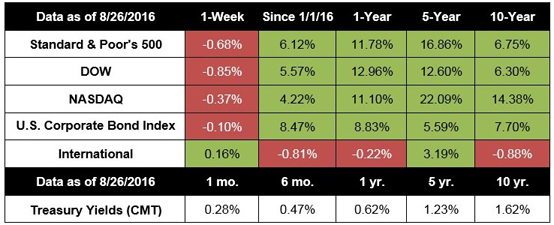 WEEKLY UPDATE – August 29, 2016
WEEKLY UPDATE – August 29, 2016
After rallying for weeks, the major indexes fell last week ahead of key remarks by Federal Reserve officials and turbulence in money markets.[1] For the week, the S&P 500 lost 0.68%, the Dow fell 0.85%, the NASDAQ dropped 0.37%, while the MSCI EAFE gained 0.16%.[2]
Even as the Fed has kept interest rates flat, an unexpected surge in short-term interest rates triggered by an industry rule change is potentially doing some of the Fed’s work for it. If you ever tune in to the financial news, you may have heard the term LIBOR (pronounced LIE-bor) mentioned in reference to money markets (what we call the trade of short-term loans between banks and other financial institutions).
LIBOR, the London Interbank Offered Rate, is a benchmark used for a vast range of debt, including mortgages and corporate loans. Recently, the three-month LIBOR (the rate charged for lending dollars for three months) has reached multi-year highs (rising more than 30% since this June), tightening credit conditions without any action by the Fed.[3]
Why should you care about LIBOR? Well, since you’re not a bank, LIBOR may not directly impact your life. However, since it’s tied to an estimated $300 trillion in global financial securities like corporate bonds and mortgages, it definitely affects your personal bottom line.[4]
Even when the Fed holds rates steady, other events can impact the interest rates we see. Restructuring related to a money market rule change is causing interest rates to rise, making it more expensive for institutions to lend to each other (and to borrowers like us).
In terms of overall impact, LIBOR’s recent spike has the equivalent impact of a small (25 basis point) rate hike by the Fed.[5] While there’s no telling how long the surge in rates will last, some analysts think that the money market turbulence will be enough to rule out an interest rate increase when the Fed meets in September.[6]
However, there are also larger stability issues the Fed has to consider. Even if a short-term rise in interest rates reduces the immediate need to raise rates, the Fed is charged with maintaining long-term stability, and may choose to act anyway.
The latest data on economic growth proved to be a disappointment. The second estimate of Gross Domestic Product growth showed that the economy grew a tepid 1.1%, trimming the previous estimate of 1.2%. While consumer spending was revised upward, businesses pulled back their spending significantly, putting the brakes on growth.[7] Will the disappointing economic growth stave off a September rate increase? Probably, but we can’t be certain.
Investors are reacting predictably to the uncertainty by holding back and waiting for more information. When trading volume is low, even minor headlines can have an outsized effect on market movements. With the next Federal Open Market Committee Meeting three weeks away, we expect to see additional volatility as investors consider the odds of a new rate hike.
ECONOMIC CALENDAR:
Monday: Personal Income and Outlays, Dallas Fed Manufacturing Survey
Tuesday: S&P Case-Shiller HPI, Consumer Confidence
Wednesday: ADP Employment Report, Chicago PMI, Pending Home Sales Index, EIA Petroleum Status Report
Thursday: Motor Vehicle Sales, Jobless Claims, Productivity and Costs, PMI Manufacturing Index, ISM Manufacturing Index, Construction Spending
Friday: Employment Situation, International Trade, Factory Orders

Notes: All index returns exclude reinvested dividends, and the 5-year and 10-year returns are annualized. Sources: Yahoo! Finance, S&P Dow Jones Indices, and Treasury.gov. International performance is represented by the MSCI EAFE Index. Corporate bond performance is represented by the SPUSCIG. Past performance is no guarantee of future results. Indices are unmanaged and cannot be invested into directly.
HEADLINES:
New home sales skyrocket. Sales of new single-family homes rose unexpectedly in July, reaching their highest level in almost nine years as demand for houses rose.[8]
Existing home sales tumble. Home resales fell last month for the first time since February as shrinking inventory limited buyer activity. However, as wages and home prices rise, resales will likely pick up later this year.[9]
Durable goods orders bounce in July. Orders for long-lasting factory goods rebounded last month, indicating the manufacturing sector may be strengthening.[10]
Consumer sentiment slips in August. A gauge of how Americans feel about the economy and their financial prospects fell. A drop in optimism could foretell weaker consumer spending this quarter.[11]
Sources:
[1] http://www.cnbc.com/2016/08/26/us-markets.html
https://www.msci.com/end-of-day-data-search
http://www.reuters.com/article/usa-moneymarkets-idUSL1N1B70CG
[4] http://www.federalreserve.gov/newsevents/speech/powell20160621a.htm
[7] http://www.cnbc.com/2016/08/26/us-q2-gross-domestic-product.html
[8] http://www.foxbusiness.com/markets/2016/08/23/july-new-home-sales-leap-12-4.html
[9] http://www.foxbusiness.com/markets/2016/08/24/existing-home-sales-fall-3-2-in-july.html
[10] http://www.foxbusiness.com/markets/2016/08/25/durable-goods-orders-rebound-in-july.html
[11] http://www.foxbusiness.com/markets/2016/08/26/consumer-sentiment-slips-in-august.html